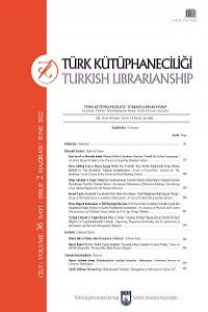Dijital Yerliler, Sosyal Ağlar ve Kütüphanelerin Geleceği
dijital kütüphaneler, dijital yerliler, sosyal ağlar, yakınsam, Web 2.0, Library 2.0
DigitalNatives, Social Networks and the Future of Libraries
digitallibraries, digitalnatives, social networks, convergence, Web 2.0, Library2.0,
___
- Not: Kaynakçada yer alan tüm çevrimiçi adreslere 23 Ekim 2009 tarihinde erişilmiştir.
- Alpert, J., veHajaj, N. (2008, July 25). We knewtheweb wasbig. http://googleblog.blogspot.com/2008/07/we-knew-web-was-big.html.
- Bayne, S.,ve Ross, J. (2007). The‘digital native' and ‘digitalimmigrant': a dangerous opposition. Paper presentedattheAnnualConferenceoftheSociety forResearch intoHigherEducation (SRHE) December2007. http://www.malts.ed.ac.uk/staff/sian/natives_final.pdf.
- Carr, N. (2008,July/August). IsGoogle makingus stupid?AtlanticMonthly, http://www.theatlantic.com/doc/200807/google.
- Dempsey, L. (2008,March2).Thetwo ways ofWeb 2.0. http://orweblog.oclc.org/archives/001556.html.
- Dempsey, L. (2009,January5).Always on:Libraries in a world ofpermanent connectivity. First Monday,14(1). http://firstmonday.org/htbin/cgiwrap/bin/ojs/index.php/fm/article/viewArticle/2291/ 2070.
- Doucet,M.(2007). Library and ArchivesCanada: A case studyofanational library, archives,and museummerger. RBM: A Journal of Rare Books, Manuscripts, and CulturalHeritage,8, 61-66. http://www.ala.org/ala/mgrps/divs/acrl/publications/rbm/8-1/doucet07.pdf.
- Dupont,C. (2007). Libraries, archives, and museums in the twenty-first century: Intersecting missions,convergingfutures? RBM: AJournalofRare Books, Manuscripts, and CulturalHeritage,8, 13-19. http://www.ala.org/ala/mgrps/divs/acrl/publications/rbm/8-1/dupont07.pdf.
- EuropeanCommission(2005).Staff working document. Annex to theCommunication from theCommission“i2010: Digital Libraries.”COM(2005) 465. http://ec.europa.eu/information_society/activities/digital_libraries/doc/communicati on/annex1_en.pdf.
- Gantz,J.F. ve diğerleri (2008 March).The diverse and explodingdigitaluniverse: An updatedforecast of worldwideinformation growth through 2011. (AnIDCWhite Paper -sponsoredby EMC)http://www.emc.com/collateral/analyst-reports/diverse- exploding-digital-universe.pdf.
- Haier, R.J., Karama, S.,Leyba,L.ve Jung, R.E.(2009 September 1). MRIassessment of cortical thickness andfunctional activity changesin adolescent girls following threemonths ofpractice on avisual-spatial task. BMCResearch Notes,2: 174. http://www.biomedcentral.com/content/pdf/1756-0500-2-174.pdf.
- Johnson,L., Levine,A., ve Smith,R. (2009). The2009Horizon Report. Austin, TX: TheNew Media Consortium. http://net.educause.edu/ir/library/pdf/CSD5612.pdf.
- Lagoze,C. (2000 November).Business unusual:how“event-awareness” may breathe lifeinto the catalog? Paper prepared forBicentennial ConferenceonBibliographic Control for theNewMillennium, Library of Congress. http://www.cs.cornell.edu/lagoze/papers/lagozelc.pdf
- Law, D. (2009). Academic digital libraries ofthefuture:an environmentscan.New Review of AcademicLibrarianship,15,53-67.
- Lynch,C.A. (2001a).Personalization andrecommender systems inthelargercontext: Newdirectionsandresearch questions. Keynotepaper presentedat SecondDELOS Network of ExcellenceWorkshop onPersonalisationandRecommender Systems in Digital Libraries, Dublin, Ireland, June 18-20,2001. http://www.ercim.org/publication/ws- proceedings/DelNoe02/CliffordLynchAbstract.pdf.
- Lynch,C.A. (2001b).The battletodefinethefuture ofthebook in the digital world. First Monday, 6(6). http://firstmonday.org/htbin/cgiwrap/bin/ojs/index.php/fm/article/view/864/773.
- Martin,R.S.(2007). Intersecting missions, converging practices. RBM:AJournal of Rare Books, Manuscripts, and Cultural Heritage,8,80-88. http://www.ala.org/ala/mgrps/divs/acrl/publications/rbm/8-1/martin07.pdf.
- Miller, P. (2005). Web 2.0:BuildingtheNew Library.Ariadne, No.45. http://www.ariadne.ac.uk/issue45/miller/intro.html.
- Murray,R.(2006).systems: synthesise, specialise, mobilise. Ariadne, No.48. http://www.ariadne.ac.uk/issue48/murray/.
- Nicholas, D., Rowlands,I., ve Huntington, P. (2007, June22).Student information seeking behaviour in context:Key findings from CIBER logstudies. http://www.jisc.ac.uk/media/documents/programmes/reppres/ggworkpackageiv.pdf.
- Ohene-Djan,J.veFernandes, A.A.A. (2003). Personalisingelectronic books,Journal of Digital Information, 3(4),[Online].http://journals.tdl.org/jodi/article/view/88/87.
- O'Reilly,T. (2005,September30).What Is Web 2.0:Design patternsandbusiness models forthenext generationof software. http://www.oreillynet.com/pub/a/oreilly/tim/news/2005/09/30/what-is-web- 20.html?page=1.
- Prensky, M.(2001a,September/October). Digitalnatives,digital immigrants. Onthe Horizon 9(5): 1-6.http://www.marcprensky.com/writing/Prensky%20- %20Digital%20Natives,%20Digital%20Immigrants%20-%20Part1.pdf.
- Prensky, M. (2001b, November/December). Digital natives, digital immigrants,Part II: Dothey reallythink differently? OntheHorizon 9(6):1-6. http://d.scribd.com/docs/25yfw2gwramobinjk3vt.pdf.
- Prensky, M.(2009).H.Sapiens Digital:Fromdigitalimmigrantsand digital natives to digitalwisdom. Innovate:Journal of Online Education, 5(3). http://www.innovateonline.info/index.php?view=article&id=705&action=article.
- Qualman, E. (2009).Socialnomics:Howsocialmedia transforms theway we live and dobusiness. Hoboken, NJ: Wiley.
- Social networksarethe new Webportals.(2009, 23January).TheIndyChannel. http://www.businessweek.com/technology/content/jan2009/tc20090121_557202.ht m.
- Springer, M. vediğerleri. (2008, October30).For thecommon good: TheLibrary of Congress Flickr Pilot Project. http://www.loc.gov/rr/print/flickr_report_final.pdf.
- Stein,F.(2007).Digital immigrants, digitalnativesand the InformationAge.MITRE (sunuşslaytları).
- Tapscott,D. (1998). Growing up digital: Theriseofthenetgeneration. New York: McGraw-Hill.
- Tapscott,D. (2009). Grown updigital: How thenetgeneration is changing your world. NewYork:McGraw-Hill.
- Toffler, A. veToffler,H.(2006).Zenginlik devrimi: Nasılyaratılacak ve hayatınızı nasıldeğiştirecek.Çev. Selim Yeniçeri.İstanbul: KoridorYayıncılık.
- Tonta,Y. (2003, August).The personalizationof informationservices, Information ManagementReport, ss. 1-6.http://yunus.hacettepe.edu.tr/~tonta/yayinlar/tonta- imr-article-revised.pdf.
- Tonta,Y. (2008a). Libraries andmuseums inthe flat world: Aretheybecomingvirtual destinations? Library Collections, Acquisitions, & Technical Services,32(1): 1-9, 2008. http://yunus.hacettepe.edu.tr/~tonta/yayinlar/tonta-lcats-2008.pdf.
- Tonta,Y. (2008b).Information servicesand Web2.0:New challenges and opportunities. AlexandraVranes &Ljiljana Markovic, Electronic Library: InternationalScientific Conference, Belgrade, September25th-28th,2008. Proceedingsiçinde (ss.237-249).Belgrade: Ministry ofCultureandMinistry of Science.http://yunus.hacettepe.edu.tr/~tonta/yayinlar/tonta-belgrade-2008-full-text- son.pdf
- Tonta,Y. (2009a).Digital nativesandvirtuallibraries: What doesthefuture hold for libraries? InternationalConferenceon Librariesand Their Clients:Free orFee ServicesSupporting Social CommunicationintheDigital Era, 1-2June2009, Krakow, Poland.http://yunus.hacettepe.edu.tr/~tonta/yayinlar/tonta-krakow-2009- full-text.pdf.
- Tonta,Y. (2009b).Preservationof scientific and culturalheritageinBalkancountries, Program:ElectronicLibrary and InformationSystems, 43,419-429. http://yunus.hacettepe.edu.tr/~tonta/yayinlar/tonta-balkan-2009.pdf.
- VanSlyke, T. (2003, May/June).Digital natives, digitalimmigrants:Somethoughts from thegenerationgap.TheTechnologySource, http://www.wisc.edu/depd/html/TSarticles/Digital%20Natives.htm.
- Weinberger, D. (2007). Everything is miscellaneous:Thepowerofthenewdigital disorder. New York:Holt.
- WhoareiProfessionals? (2009). http://www.ischools.org/site/alumni/.
- Wythe,D.(2007). New technologies and convergence of libraries,archives and museums. RBM: AJournal ofRareBooks,Manuscripts, and Cultural Heritage, 8, 51-55. http://www.ala.org/ala/mgrps/divs/acrl/publications/rbm/8-1/wythe07.pdf.
- Yayın Aralığı: 4
- Başlangıç: 1952
- Yayıncı: Türk Kütüphaneciler Derneği
Global Library and Information Science: A Textbook For Students and Educators
Demokratik Kitle Örgütü Olarak Türk Tabipleri Birliği
Mesleki Örgütlenme ve 60. Yılında TKD
Association des Bibliothecaires Francais ABF French Librarians Association
TKD Ankara Şubesi'nde 90'lı Yılların Başları
Berufsverband Information Bibliothek e.V. BIB Enformasyon ve Kütüphane Meslek Derneği
Susanne RİEDEL, Sanem YARDIMCI
Türk Kütüphaneciliği Dergisi Dizinleri 1952 - 2007 : Örnek Bir Grup Çalışması
Mesleki bir örgüt olarak Türk Kütüphaneciler Derneği'nin altmış yıllık gelişim çizgisi
Türk Kütüphaneciler Derneği 60 Yaşında
